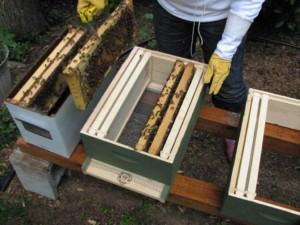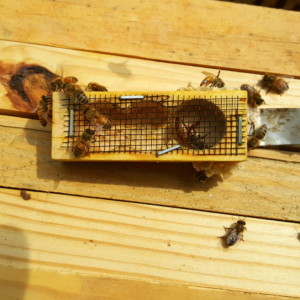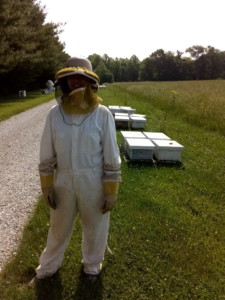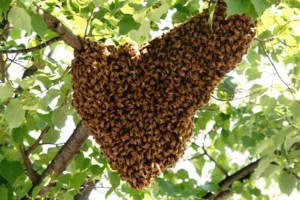Springtime: Flowers are blooming, birds are chirping, and bees are buzzing back to WonderLab! This is an especially exciting time of year as we are looking forward to receiving the beginnings of our new honeybee colony from Hunter’s Honey Farm in Martinsville, Indiana.
WonderLab Needs a New Bee Colony and Queen
This story begins in November of 2019 when the WonderLab Animal Care staff noticed a few hive beetles in the museum demonstration hive. Hive beetles are parasitic beetles that feed on the comb and honey of a hive, eventually leading to its collapse.
–READ MORE: For more information on hive beetles, you can visit the USDA website–
At first the WonderLab bees were doing a good job at keeping the hive beetles at bay by separating them from the bee population. But by the middle of December, the number of hive beetles began to rise and the bees lost control. Hive beetles eventually took over the hive, ate all the resources, and collapsed the hive. The bees were gone. By the end of December, the whole hive had died.
How WonderLab Gets a New Bee Colony
When creating exhibits and experiences, WonderLab works with partners, both locally and nationally. For an exhibit such as the beehive, WonderLab works with local apiaries such as Hunter’s Honey Farm in Martinsville, Indiana. In early January, the WonderLab Animal Care staff ordered a new colony from Hunter’s.
In nature, new bee colonies are formed when an established single bee colony splits into two or more distinct colonies. This process, called swarming, is a honey bee colony’s natural means of reproduction, occurring when an active hive outgrows its space.–READ MORE: Why and How Bees Swarm–
Hunter’s Honey Farm has many hives that are almost to the point of swarming. To relieve pressure on large, established hives, the Hunter’s beekeepers create a nucleus, also known as an artificial swarm. In apiary terminology, a nucleus (aka nuc for short) is a set of 3-5 wooden frames of comb, honey, pollen, brood, and roughly a few hundred bees.
This practice helps keep the established hive from swarming. In nature new queens are born as part of the swarming process. The act of creating a nuc, an artificial swarm, creates a colony without a queen.

This is an example of a fully stocked nuc that is ready to be introduced to a new queen. Notice that it comes all ready with honey stores, brood, pollen, and workers.
–READ MORE: How honey bee queens are created–
All Hail the Queen (aka we gotta get a queen)

Here is an example of a queen in a sugar chamber. There are workers eating their way in as she is eating her way out. This slowly introduces the workers to her pheromones.
All bee colonies require a queen to survive. Bees are eusocial animals which means that in a big group of them (hive in this case) only one individual reproduces and all the others help her in producing and rearing offspring. She is totally taken care of by her offspring and her only job is to reproduce. Without her, no other bees are made. Because the nuc does not have a queen a new one must be introduced. But introducing an outside queen into an established hive is a delicate operation. Because the new queen is not related to the workers, there is a chance the workers will reject the queen and kill her. To keep this from happening, a new queen will be put in a small chamber capped by a sugar plug. The workers will chew the plug from the outside in while the queen chews from the inside out.
As this occurs, the workers will be slowly introduced to the queen’s pheromones. Every queen bee makes her own distinct pheromone. By slowly introducing the workers to the queen’s unique pheromones, the workers are more likely to accept her and take her on as their own queen.
After the queen is eaten out of the sugar capsule, the beekeepers at Hunter’s Honey Farm will carefully monitor her. They will watch to ensure that she has been assimilated to the nuc and has started to lay eggs. Once this happens, WonderLab staff will pick up the nuc and install it in our iconic observation hive.

Meredith Hardy views the observation hive on the second floor of WonderLab Museum of Science, Health & Technology
Installing the Hive
Safe weather conditions are a key factor that must be considered when safely installing a new bee hive. Staff must wait for a day when the temperature is above 60°F; low temperatures can kill the developing bees. We also want a day with no rain so the comb will not be flooded.
Once the bees arrive and the weather cooperates, we call in the assistance of local beekeeping expert, George Hegeman. George is a Professor Emeritus of Microbiology at Indiana University in Bloomington and experienced beekeeper of decades. Staff will get suited up in protective gear, and move our gallery observation hive from the museum out to the garden. There we will open our new box with the colony and gently “smoke” the bees. Smoke slows the bees, inducing a calm state, making it easier for us to handle the frames.

WonderLab Animal Care Intern Gabrielle Gilbert is seen here dressed in full honey bee personal protective equipment including a hat, veil, gloves and coveralls. She is at Hunter’s Honey Farm picking up the 2018 honey bee hive.
Once the bees relax, George and WonderLab staff will transfer the four frames into the museum observational hive. All hive openings will be closed temporarily so that the bees cannot traffic in and out as we move them through the building to their new home on the museum’s second floor. Once in the place the barriers will be removed allowing the bees full access to the outside through a tube connecting the hive to our garden.
At this point, the hive will settle, the queen will lay eggs, the workers will make honey and they will await the return of our visitors!
For more details on the transferring process and to learn why smoke slows down bees and what observational hives are, tune into my next blog post, where I will give you the play by play of how the installation of WonderLab’s 2020 honey bee royalty went. We look forward to seeing all of you at WonderLab again and our bees will be here waiting for you when we do!
Want to learn more?
Starting a beehive
https://www.perfectbee.com/your-beehive/starting-a-beehive/obtaining-and-installing-a-nuc-colony
Varroa Mites
https://ucanr.edu/blogs/blogcore/postdetail.cfm?postnum=9115
https://www.wonderlab.org/mites-might-be-mighty/
About the Author:


Leave A Comment